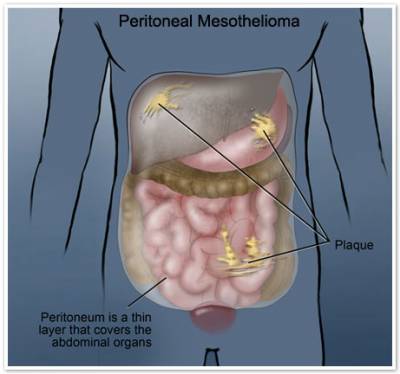
- 13.09.2014
- 3224 Просмотра
- Обсудить
Malignant peritoneal mesothelioma is a rare type of cancer that occurs in the thin cell walls surrounding the abdominal cavity, known as the peritoneum. This thin membrane acts a lubricant within the abdominal cavity so that surrounding organs and internal body structures may contract and expand within their normal body function. Incidence of peritoneal mesothelioma is quite rare, and typically presents in less than 500 individuals in the United States each year.
Other types of mesothelioma include the more common malignant pleural mesothelioma, occurring in the chest wall membrane surrounding the lungs, and malignant pericardial mesothelioma, which occurs in the pericardial lining of the heart. Peritoneal mesothelioma is the second rarest form of the disease and accounts for approximately 20% of all mesothelioma cases each year.
What Causes Peritoneal Mesothelioma?
Peritoneal mesothelioma is known only to be caused by exposure to asbestos, a microscopic natural fiber that was used heavily in industry. Asbestos is said to reach the abdominal wall by one of two methods. The first is through ingested asbestos fibers which are processed through digestion and become lodged in the peritoneum. The other method is through the lungs and lymph nodes by inhaled asbestos fibers. Malignant mesothelioma of the pleura is also known to metastasize directly into the abdominal cavity if its spread is not slowed.
Many of those who have worked with asbestos materials have developed peritoneal mesothelioma as a result of exposure to friable asbestos fibers. Asbestos was used in a myriad of industrial materials and construction products. Exposure to asbestos was common in aluminum plants, steel mills, power plants, and naval shipyards.
Peritoneal mesothelioma is a relatively rare disease, with only 200-500 diagnoses each year in the United States being documented. Risk, however, is sustained in those who have been exposed to asbestos. Even those exposed many years ago are potentially at risk for the development of malignant peritoneal mesothelioma. Latency between exposure to asbestos and the development of peritoneal mesothelioma symptoms can range anywhere from 20-50 years. Misdiagnosis is common because peritoneal mesothelioma symptoms closely mimic minor stomach/abdominal discomfort and hernia. Nevertheless, those with clear asbestos exposure history should be aware of their risk of disease and speak with their doctor or cancer specialist if they believe they may be experiencing symptoms indicative of mesothelioma.
How is Peritoneal Mesothelioma Treated?
Prognosis of mesothelioma patients is poor, and peritoneal mesothelioma patients are no exception. Most peritoneal treatment regimens for patients include palliative methods such as mesothelioma chemotherapy and radiation therapy. However, if the disease is diagnosed in its earlier stages, patients such as those diagnosed with stage 1 mesothelioma, may be eligible for surgical resection of the disease, which could potentially add years to the initial prognosis.
Surgery is possible for patients diagnosed with earlier-stage disease. Some surgical options include peritonectomy and palliative procedures. Certain physicians, including Dr. David Sugarbaker of the International Mesothelioma Program at Brigham and Women’s Hospital in Boston, MA, have become extremely well versed and experienced in the surgical treatment of malignant mesothelioma. In many cases, surgical treatment for mesothelioma will be coupled with chemotherapy or radiation therapy regimens.
Chemotherapy is the most common treatment for mesothelioma disease. Currently, there is only a single chemotherapy regimen (Alimta® (pemetrexed) in conjunction with Cisplatin) approved by the Food and Drug Administration as a prescribed therapy for the treatment of malignant pleural mesothelioma. There are however, dozens of clinical trials being conducted for mesothelioma patients experimenting with new drugs, including Gemcitabine, Navelbine, Onconase, and others for the treatment of malignant peritoneal mesothelioma.
How is Peritoneal Mesothelioma Diagnosed?
Doctors may suspect peritoneal mesothelioma if the patient complains of stomach, chest, or abdominal pain. Suspicious hernias may actually be a peritoneal effusion caused by peritoneal tumor growth. Misdiagnosis is common and patients will likely undergo multiple imaging scans and a diagnostic biopsy before an official diagnosis is made.
Diagnostic procedures in which fluid is extracted from the peritoneum for lab testing are the only way to conclusively diagnose peritoneal mesothelioma. Samples will be examined for the presence of malignant cells. Once malignant cells are detected, further testing will be needed to classify these cells as malignant mesothelioma.
What are a patient's options?
Patients of peritoneal mesothelioma may be eligible for financial compensation if they were harmfully exposed to asbestos. For additional information on your legal rights regarding mesothelioma please fill out the brief form on this page.
Будь-те первым, поделитесь мнением с остальными.


